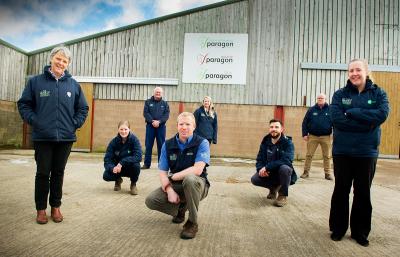
The latest developments in IVF are giving farmers the ability to improve their herds more quickly than ever before.
IVF technology allows the farmer to produce multiple offspring from animals with a higher health and welfare status (less disease and lower antibiotic requirements), more productive and profitable animals and more sustainable animals (delivering better feed efficiency and a lower carbon footprint).
The advanced breeding revolution first took hold in the 1980s when Multiple Ovulation Embryo Transfer (MOET) with flushing became established as a successful and popular technique.
Now the best IVF teams are accelerating herd improvement further, giving farmers the ability to reproduce high value genetics and desirable traits very rapidly.
A quality female is now potentially able to produce more than a dozen offspring in a year, fertilised by elite sires.
In the beginning IVF was mainly used on problem breeder cows but it is increasingly becoming a central method for herd improvement in both beef and dairy.
The technique is known as In Vitro Fertilisation (IVF) or In Vitro Production (IVP). In vitro means ‘in glass’, referring to the laboratory petri dish or tube.
The process at Paragon Advanced Breeding begins with the removal of the dominant follicle, which allows a new wave of fresh follicles to start. These follicles are then stimulated using low levels of hormone and we find this method produces more and better quality follicles to come forward than non-stimulated collections.
A week later the follicles are aspirated and early-stage eggs known as ooctyes are recovered – a process called Ovum Pick-Up (OPU). This is done by carefully inserting a needle into the follicles, guided by an ultrasound image. The procedure is done with the cow standing but under epidural anaesthetic, which ensures the cow doesn’t feel anything and the procedure is pain free.
The next stages take place in the laboratory. Here, the oocytes are kept for 23 hours before being fertilised in vitro and then cultured for a week. After seven days any embryos that have developed can then be transferred fresh into recipient cows or frozen for the future.

We have invested in some top-spec facilities at Paragon Advanced Breeding for our IVF service.
Cows can come to us as day patients or residential. We have a specially designed heated collection building to maximise oocyte survival, as these early-stage eggs are sensitive to temperature. And we have a dedicated on-site laboratory. We have two other temperature-controlled collection facilities in Cumbria.
Why all this tech and investment? This is how we achieve our high success rates, giving farmers the most efficient return on their outlay. We are at the elite end of what we do. We don’t cut any corners. We aim to optimise results.
When Paragon’s Advanced Breeding lead vet Rob Simmons and colleague Dan Griffiths started working on IVF in 2016 the average embryo production per collection was just below two.
Now we are averaging 5.8 embryos per collection. In some cases, results can be very much higher.
Recently we produced 45 grade one embryos from a single collection from a quality Limousin cow, fertilised by three different leading sires. This gives the farmer many options to improve his own herd as well as to sell on desirable frozen embryos.
We think that part of the secret of our success with IVF is that our team has great attention to detail, and we have a lot of experience and understanding of the work we are doing.
There are a number of advantages to going down the IVF route.
We can collect oocytes from prepubescent calves as young as 8 months of age. They can be transferred into older animals, with those calves born before the genetic mother has her own calf on the ground. Collections can also be made from pregnant females during the first trimester of pregnancy.
IVF also allows a farmer to use different sires on eggs from a single collection.
IVF collections can be made more frequently - fortnightly on an ongoing basis, compared with conventional flushing where it would be uncommon to flush a cow more than 3 or 4 times a year. IVF is also useful for some problem breeder cows where flushing is not successful, for example those with blocked tubes, or adhesions associated with caesareans, or cows with vaginal prolapses.
Frozen embryos will produce calves even decades later. However, transferring IVF embryos fresh, rather than freezing them, gets the best results.
We find that the conception rate with frozen IVF embryos is around 45 – 50 per cent, while it rises to approximately 55 – 60 per cent when they are transferred fresh. However, attention to detail with recipient management is essential in order to get the best results.
With fresh transfer it is important to plan ahead so that collection from the donor cow and readiness of recipient animals are exactly co-ordinated.
Recipient animals need the embryo to be implanted seven days after their heat. Preparations for recipients include selecting suitable animals, feeding and management, and synchronisation of their reproductive cycles using progesterone devices.
The farmer needs to be thinking about whether they want to prepare recipients for potential fresh transfer around a month before the collection date.